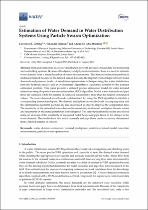 ResearchSpace
ResearchSpace
Estimation of water demand in water distribution systems using particle swarm optimization
JavaScript is disabled for your browser. Some features of this site may not work without it.
- ResearchSpace
- →
- Research Publications/Outputs
- →
- Journal Articles
- →
- View Item
| dc.contributor.author |
Letting, LK

|
|
| dc.contributor.author |
Hamam, Y

|
|
| dc.contributor.author |
Abu-Mahfouz, Adnan MI

|
|
| dc.date.accessioned | 2018-05-28T07:29:53Z | |
| dc.date.available | 2018-05-28T07:29:53Z | |
| dc.date.issued | 2017-08 | |
| dc.identifier.citation | Letting, L., Hamam, Y. and Abu-Mahfouz, A.M.I. 2017. Estimation of water demand in water distribution systems using particle swarm optimization. Water, vol 9(8), pp 1-16 | en_US |
| dc.identifier.issn | 2073-4441 | |
| dc.identifier.uri | http://www.mdpi.com/2073-4441/9/8/593 | |
| dc.identifier.uri | http://hdl.handle.net/10204/10237 | |
| dc.description | Copyright: 2017. MDPI | en_US |
| dc.description.abstract | Demand estimation in a water distribution network provides crucial data for monitoring and controlling systems. Because of budgetary and physical constraints, there is a need to estimate water demand from a limited number of sensor measurements. The demand estimation problem is underdetermined because of the limited sensor data and the implicit relationships between nodal demands and pressure heads. A simulation optimization technique using the water distribution network hydraulic model and an evolutionary algorithm is a potential solution to the demand estimation problem. This paper presents a detailed process simulation model for water demand estimation using the particle swarm optimization (PSO) algorithm. Nodal water demands and pipe flows are estimated when the number of estimated parameters is more than the number of measured values. The water demand at each node is determined by using the PSO algorithm to identify a corresponding demand multiplier. The demand multipliers are encoded with varying step sizes and the optimization algorithm particles are also discretized in order to improve the computation time. The sensitivity of the estimated water demand to uncertainty in demand multiplier discrete values and uncertainty in measured parameters is investigated. The sensor placement locations are selected using an analysis of the sensitivity of measured nodal heads and pipe flows to the change in the water demand. The results show that nodal demands and pipe flows can be accurately determined from a limited number of sensors. | en_US |
| dc.language.iso | en | en_US |
| dc.publisher | MDPI | en_US |
| dc.relation.ispartofseries | Workflow;20528 | |
| dc.subject | Water demand estimation | en_US |
| dc.subject | Particle swarm optimization | en_US |
| dc.subject | Demand multipliers | en_US |
| dc.subject | Under determined model | en_US |
| dc.subject | Uncertain measurements | en_US |
| dc.title | Estimation of water demand in water distribution systems using particle swarm optimization | en_US |
| dc.type | Article | en_US |
| dc.identifier.apacitation | Letting, L., Hamam, Y., & Abu-Mahfouz, A. M. (2017). Estimation of water demand in water distribution systems using particle swarm optimization. http://hdl.handle.net/10204/10237 | en_ZA |
| dc.identifier.chicagocitation | Letting, LK, Y Hamam, and Adnan MI Abu-Mahfouz "Estimation of water demand in water distribution systems using particle swarm optimization." (2017) http://hdl.handle.net/10204/10237 | en_ZA |
| dc.identifier.vancouvercitation | Letting L, Hamam Y, Abu-Mahfouz AM. Estimation of water demand in water distribution systems using particle swarm optimization. 2017; http://hdl.handle.net/10204/10237. | en_ZA |
| dc.identifier.ris | TY - Article AU - Letting, LK AU - Hamam, Y AU - Abu-Mahfouz, Adnan MI AB - Demand estimation in a water distribution network provides crucial data for monitoring and controlling systems. Because of budgetary and physical constraints, there is a need to estimate water demand from a limited number of sensor measurements. The demand estimation problem is underdetermined because of the limited sensor data and the implicit relationships between nodal demands and pressure heads. A simulation optimization technique using the water distribution network hydraulic model and an evolutionary algorithm is a potential solution to the demand estimation problem. This paper presents a detailed process simulation model for water demand estimation using the particle swarm optimization (PSO) algorithm. Nodal water demands and pipe flows are estimated when the number of estimated parameters is more than the number of measured values. The water demand at each node is determined by using the PSO algorithm to identify a corresponding demand multiplier. The demand multipliers are encoded with varying step sizes and the optimization algorithm particles are also discretized in order to improve the computation time. The sensitivity of the estimated water demand to uncertainty in demand multiplier discrete values and uncertainty in measured parameters is investigated. The sensor placement locations are selected using an analysis of the sensitivity of measured nodal heads and pipe flows to the change in the water demand. The results show that nodal demands and pipe flows can be accurately determined from a limited number of sensors. DA - 2017-08 DB - ResearchSpace DP - CSIR KW - Water demand estimation KW - Particle swarm optimization KW - Demand multipliers KW - Under determined model KW - Uncertain measurements LK - https://researchspace.csir.co.za PY - 2017 SM - 2073-4441 T1 - Estimation of water demand in water distribution systems using particle swarm optimization TI - Estimation of water demand in water distribution systems using particle swarm optimization UR - http://hdl.handle.net/10204/10237 ER - | en_ZA |





